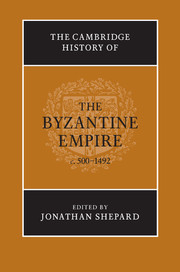Book contents
- Frontmatter
- General Introduction
- Part I The Earlier Empire c. 500–c. 700
- Part II The Middle Empire c. 700–1204
- 5 State of Emergency (700–850)
- 6 After Iconoclasm (850–886)
- 7 Religious Missions
- 8 Armenian Neighbours (600–1045)
- 9 Confronting Islam: Emperors Versus Caliphs (641–c. 850)
- 10 Western Approaches (700–900)
- 11 Byzantine Italy (680–876)
- 12 The Middle Byzantine Economy (600–1204)
- 13 Equilibrium to Expansion (886–1025)
- 14 Western Approaches (900–1025)
- 15 Byzantium and Southern Italy (876–1000)
- 16 Belle Époque or Crisis? (1025–1118)
- 17 The Empire of the Komnenoi (1118–1204)
- 18 Balkan Borderlands (1018–1204)
- 19 Raiders and Neighbours: The Turks (1040–1304)
- Part III The Byzantine Lands in the Later Middle Ages 1204–1492
- Glossary (Including some Proper Names)
- Genealogical Tables and Lists of Rulers
- List of alternative place names
- Bibliography
- Picture Acknowledgements
- Index
- References
9 - Confronting Islam: Emperors Versus Caliphs (641–c. 850)
from Part II - The Middle Empire c. 700–1204
Published online by Cambridge University Press: 28 March 2010
- Frontmatter
- General Introduction
- Part I The Earlier Empire c. 500–c. 700
- Part II The Middle Empire c. 700–1204
- 5 State of Emergency (700–850)
- 6 After Iconoclasm (850–886)
- 7 Religious Missions
- 8 Armenian Neighbours (600–1045)
- 9 Confronting Islam: Emperors Versus Caliphs (641–c. 850)
- 10 Western Approaches (700–900)
- 11 Byzantine Italy (680–876)
- 12 The Middle Byzantine Economy (600–1204)
- 13 Equilibrium to Expansion (886–1025)
- 14 Western Approaches (900–1025)
- 15 Byzantium and Southern Italy (876–1000)
- 16 Belle Époque or Crisis? (1025–1118)
- 17 The Empire of the Komnenoi (1118–1204)
- 18 Balkan Borderlands (1018–1204)
- 19 Raiders and Neighbours: The Turks (1040–1304)
- Part III The Byzantine Lands in the Later Middle Ages 1204–1492
- Glossary (Including some Proper Names)
- Genealogical Tables and Lists of Rulers
- List of alternative place names
- Bibliography
- Picture Acknowledgements
- Index
- References
Summary
introduction
Two features characterise Byzantine–Muslim relations between the seventh and ninth century: a finely tuned link between domestic strife and the external fortunes of war and diplomacy; and the fitful involvement of both polities’ leaders with their armed forces, without exercise of personal command. The Arabs’ dramatic conquest of Byzantium’s eastern territories in the 630s was followed by four further periods of Muslim expansion; by gradual stabilisation; and then by Byzantine strengthening and eventual territorial recovery. The four periods of Muslim expansion were all brought to an end by bouts of civil war (fitna) among the Muslims, the first lasting from 656 until 661. The second expansionary period under the Sufyanid Umayyad caliphs was followed by almost ten years of civil war, from 683 until 692; the third, under the Marwanid caliphs – the final branch of the Umayyad dynasty – was broken by infighting for some two years between 718 and 720, only to be followed by a twenty further years or so of aggressive campaigning. The violent replacement of the Umayyads by the Abbasids in the mid-eighth century owed nothing to Byzantium, nor did it halt military and diplomatic interaction between the two polities; but it did transform Arab–Byzantine relations.
the parameters of conflict
The most vulnerable period for Byzantium came immediately after the disastrous battle of the river Yarmuk in 636, during the imperial succession crisis triggered by Heraclius’ death in 641 and in the earliest years of his successor Constans II (641–68) (see above, pp. 230–1). After the withdrawal of their armies from Syria and northern Mesopotamia, the Byzantines had managed to regroup by the late 630s and early 640s and create new Anatolian defences, taking advantage of the Taurus mountains and key fortified points in the interior. Although limited truces had previously been struck with the Arabs, no formal, linear frontier was ever established and hostilities persisted. Fortunately for the Byzantines, the Muslims had priorities elsewhere.
- Type
- Chapter
- Information
- The Cambridge History of the Byzantine Empire c.500–1492 , pp. 365 - 394Publisher: Cambridge University PressPrint publication year: 2009
References
- 1
- Cited by

